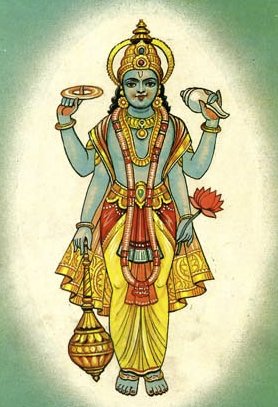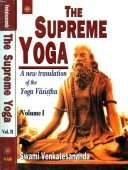Bhushunda, Bhuśuṇḍa, Bhuṣuṇḍa: 9 definitions
Introduction:
Bhushunda means something in Hinduism, Sanskrit. If you want to know the exact meaning, history, etymology or English translation of this term then check out the descriptions on this page. Add your comment or reference to a book if you want to contribute to this summary article.
The Sanskrit terms Bhuśuṇḍa and Bhuṣuṇḍa can be transliterated into English as Bhusunda or Bhushunda, using the IAST transliteration scheme (?).
In Hinduism
Purana and Itihasa (epic history)
Source: archive.org: A History of Indian Philosophy (purana)Bhuśuṇḍa (भुशुण्ड), the venerable old crow who was enjoying an exceptionally long life, is supposed to instruct Vaśiṣṭha (VI.24) on the subject of prāṇa. He compares the body to a house with the ego (ahaṃkāra) as the householder. It is supposed to be supported by pillars of three kinds, provided with nine doors (seven apertures in the head and two below), tightly fitted with the tendons (snāyu) as fastening materials and cemented with blood, flesh and fat. On the two sides of it there are the two nāḍīs, iḍā and piṅgalā, lying passive and unmanifested. There is also a machine (yantra) of bone and flesh (asthi-māṃsa-maya) in the shape of three double lotuses (padma-yugma-traya) having pipes attached to them running both upwards and downwards and with their petals closing upon one another.
Source: archive.org: Puranic EncyclopediaBhuśuṇḍa (भुशुण्ड).—A dispassionate and large-hearted crow. The residence of this crow was a Kalpavṛkṣa standing on a beautiful peak surrounded by luxuriant vegetation in the north-eastern corner of Mahāmeru. There were numerous bird-nests on the southern branch of that Kalpavṛkṣa. In one of them lived this centuries-old bird.
Once when the sage Vasiṣṭha went to Devaloka, he happened to hear about this crow. He went to see Bhuśuṇḍa in its nest. The crow recognised Vasiṣṭha at once. They exchanged greetings. The sage opened the conversation as follows:—"Oh, King of birds! when were you born? How did you become a great soul? How old are you? Have you recollections of the past? Who was the prophet who suggested this residence for you?" (See full article at Story of Bhuśuṇḍa from the Puranic encyclopaedia by Vettam Mani)
Source: archive.org: Shiva Purana - English TranslationBhuśuṇḍa (भुशुण्ड) refers to a type of weapon used in battle, according to the Śivapurāṇa 2.5.9 (“Śiva’s campaign”).—Accordingly, as Śiva with the Gods attacked Tripura: “[...] The leading gods as huge as mountains went ahead delighted and well-armed with all sorts of missiles (bhuśuṇḍa [?]), plough-shares, mortars, iron clubs and uprooted trees as huge as mountains. Then Indra, Brahmā, Viṣṇu and others went ahead of lord Śiva jubilantly shouting cries of victory to Śiva, well-armed with various weapons and shining brilliantly. Sages with matted hair and staffs in the hands rejoiced. Siddhas and Cāraṇas moving about in the sky showered flowers. [...]”.

The Purana (पुराण, purāṇas) refers to Sanskrit literature preserving ancient India’s vast cultural history, including historical legends, religious ceremonies, various arts and sciences. The eighteen mahapuranas total over 400,000 shlokas (metrical couplets) and date to at least several centuries BCE.
Vaishnavism (Vaishava dharma)
Source: Devotees Vaishnavas: Śrī Garga SaṃhitāBhuṣuṇḍa (भुषुण्ड) is the name of Aśvaśirā after he became a crow on Mount Nīla according to the Garga-saṃhitā 2.13.15. Accordingly, “...O Aśvaśirā, hear My words. Don't lament. Please don't lament. You will have the form of a crow, but you will have transcendental knowledge. You will have yoga-siddhis and the highest knowledge in the three worlds. Śrī Nārada said: After speaking these words, Lord Viṣṇu departed. O king, then the sage Aśvaśirā became the crow Bhuṣuṇḍa on Mount Nīla”.

Vaishnava (वैष्णव, vaiṣṇava) or vaishnavism (vaiṣṇavism) represents a tradition of Hinduism worshipping Vishnu as the supreme Lord. Similar to the Shaktism and Shaivism traditions, Vaishnavism also developed as an individual movement, famous for its exposition of the dashavatara (‘ten avatars of Vishnu’).
Yoga (school of philosophy)
Source: Brill: Śaivism and the Tantric Traditions (yoga)Bhuśuṇḍa (भुशुण्ड) is the name of a practitioner of Haṭhayoga, according to Śivānandasarasvatī’s Yogacintāmaṇi, a 17th-century text on Haṭhayoga by consisting of 3423 verses.—Accordingly, “[...] I have revealed here all that which is secret in Haṭha- and Rājayoga for the delight of Yogins. However, that Haṭhayoga which was practised by Uddālaka, Bhuśuṇḍa and others has not been mentioned by me, because it cannot be accomplished by contemporary [practitioners. Also], the procedures and so forth promoted by the kāpālikas have not been mentioned [because] they contravene the Vedas, Dharmaśāstras and Purāṇas”.
Source: ORA: Amanaska (king of all yogas): A Critical Edition and Annotated Translation by Jason BirchBhuśuṇḍa (भुशुण्ड) is the name of an ancient Yogi, according to the Amanaska Yoga treatise dealing with meditation, absorption, yogic powers and liberation.—Accordingly, as Īśvara says to Vāmadeva: “[...] Thus, by practising absorption which increases by degrees, the Yogins enjoy supreme bliss, like the great-souled Bhuśuṇḍa and others. Even in the dissolutions of Brahmā, Viṣṇu and Śiva, the yogins enjoy supreme bliss, like the great-souled Bhuśuṇḍa and others. [...]”.
Note: The example of Bhuśuṇḍa in 1.85-86 is undoubtedly a reference to the story of Bhuśuṇḍa, the crow, in chapters fourteen to twenty-seven of the sixth Prakaraṇa (i.e., the Nirvāṇaprakaraṇa) of the Mokṣopāya (alias Yogavāsiṣṭha). [...] The particular relevance of Bhuśuṇḍa to the Amanaska is that he survived the conflagration at the end of the world by the practice of concentration (dhāraṇā) on the gross elements.

Yoga is originally considered a branch of Hindu philosophy (astika), but both ancient and modern Yoga combine the physical, mental and spiritual. Yoga teaches various physical techniques also known as āsanas (postures), used for various purposes (eg., meditation, contemplation, relaxation).
Languages of India and abroad
Sanskrit dictionary
Source: Cologne Digital Sanskrit Dictionaries: Monier-Williams Sanskrit-English DictionaryBhuśuṇḍa (भुशुण्ड):—m. Name of a man, [Catalogue(s)]
[Sanskrit to German]
Sanskrit, also spelled संस्कृतम् (saṃskṛtam), is an ancient language of India commonly seen as the grandmother of the Indo-European language family (even English!). Closely allied with Prakrit and Pali, Sanskrit is more exhaustive in both grammar and terms and has the most extensive collection of literature in the world, greatly surpassing its sister-languages Greek and Latin.
See also (Relevant definitions)
Full-text (+56): Kramavivriddha, Mahatmavat, Vivriddha, Khinna, Pratikalpa, Praudha, Utpatavayu, Praudhamanasa, Vidita, Jagadvidita, Agamapaya, Yugapaya, Kalpanta, Utpata, Vijvara, Dirghayus, Yugagama, Cakraparampara, Calamity, Shakalita.
Relevant text
Search found 9 books and stories containing Bhushunda, Bhuśuṇḍa, Bhusunda, Bhuṣuṇḍa; (plurals include: Bhushundas, Bhuśuṇḍas, Bhusundas, Bhuṣuṇḍas). You can also click to the full overview containing English textual excerpts. Below are direct links for the most relevant articles:
Garga Samhita (English) (by Danavir Goswami)
Verse 2.13.15 < [Chapter 13 - The Story of Śeṣa]
Yoga Vasistha [English], Volume 1-4 (by Vihari-Lala Mitra)
Chapter XVI - Conversation of vasishtha and bhusunda < [Book VI - Nirvana prakarana part 1 (nirvana prakarana)]
Chapter XXVII - Conclusion of the narrative of bhusunda < [Book VI - Nirvana prakarana part 1 (nirvana prakarana)]
Chapter V - Narrative of a vidyadhara and his queries < [Book VII - Nirvana prakarana part 2 (nirvana prakarana)]
Puranic encyclopaedia (by Vettam Mani)
Shaiva Upanishads (A Critical Study) (by Arpita Chakraborty)
1. Genesis of ‘Rudrākṣa’ < [Chapter 4 - A Critical approach to Rudrākṣa based on Śaiva Upaniṣads]
11-12. Process and Method of Wearing Rudrākṣa < [Chapter 4 - A Critical approach to Rudrākṣa based on Śaiva Upaniṣads]
8. Various faces of Rudrākṣa and their benefits < [Chapter 4 - A Critical approach to Rudrākṣa based on Śaiva Upaniṣads]
Laghu-yoga-vasistha (by K. Narayanasvami Aiyar)
The Skanda Purana (by G. V. Tagare)
Chapter 2 - Yama’s Prayer < [Section 2 - Puruṣottama-kṣetra-māhātmya]
Related products

